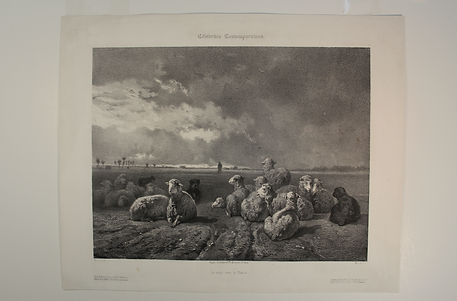Undergraduate research on the history of Barbizon by Julia Mielke

“La Hutte: Forêt de Fontainebleau”
Théophile-Narcisse Chauvel
About Barbizon
The Barbizon School was created by Théodore Rousseau and Jean-François Millet in 1848, when the two artists left Paris due to a lack of success from conflicting styles with the Romantic era. Other artists began to follow to Barbizon to settle, as they were promised room and board at the Auberge Ganne Inn. The inn had been owned by François Ganne and his wife Edmée since the 1920s.
Seeking fresh inspiration, artists would scatter within the Fontainebleau Forest to paint “sur le motif”, which translates to “from nature”. After long days of being immersed outside in the forest, the artists came back together to share the techniques, ideas, and concepts which they had discovered. The inn soon became considered a school, and today is a museum of the history of Barbizon art and artists.
Barbizon is most known for paintings, making the history of other mediums in Barbizon more difficult to research. Prints produced by artists of the Barbizon School were only brought to the public eye during the school’s time through the collaboration of French printers and publishers of art magazines, including the Gazette des Beaux-Arts. The efforts of the artists, printers and publishers resulted in the establishment of the popularity and importance of the Barbizon school, which sparked the beginning of French Realism, and Impressionism in the following generation. In the history of art, the Barbizon school served as a transition from French Romanticism to the beginning of French Impressionism.

Millet on left, Rousseau on right.
“But indeed, it is not so much for its beauty that the forest makes a claim upon mens hearts, as for that subtle something, that quality of the air, that emanation from the old trees, that so wonderfully changes and renews a weary spirit.” -Robert Louis Stevenson

“Une Bêcheur”
Georges Belin-Dollet

Romanticism is defined as Neoclassical, which is a style or art aesthetic based off of imitation of classical art, such as that from Greece or Rome. Neoclassical art can be thought of as “inspired by antiquity”. Romanticism was known for evoking emotion from mythological, religious or historical narratives.
Barbizon led the way towards realism art, bringing every day life into artworks. Realism was concerned with how life was structured socially, economically, politically, and culturally in the mid-19th century. This led to images of life's unpleasant moments, such as intense working labor and the life of the peasant class. However, realism also focused on the realistic, natural beauty of the environment. Barbizon artists
incorporated a sense spirituality within their work, as they thought of realism as a way to evoke human emotions and the states of the soul within themselves, and upon others within their work.
The artists of Barbizon wanted to capture nature as it truly was-representing it’s natural beauty. Thus, prompting realism to be the focus of the Barbizon school.
Later on in the school’s life, the Barbizon artists assisted in moving the French art world towards impressionism. After many years in the surrounding forest, artists wanted to recreate places where they could find, “more water and light but also the modern subjects of the cities and the leisures.” This lead Barbizon to expand further than the forest of Fontainebleau, and progressively spark the beginning stages of impressionism.
To further understand the influence of Barbizon, read the history of the Barbizon artists who started it all.
“Le Matin dans la Prairie”
Constant Troyon
"August"
Karel Dujardi
